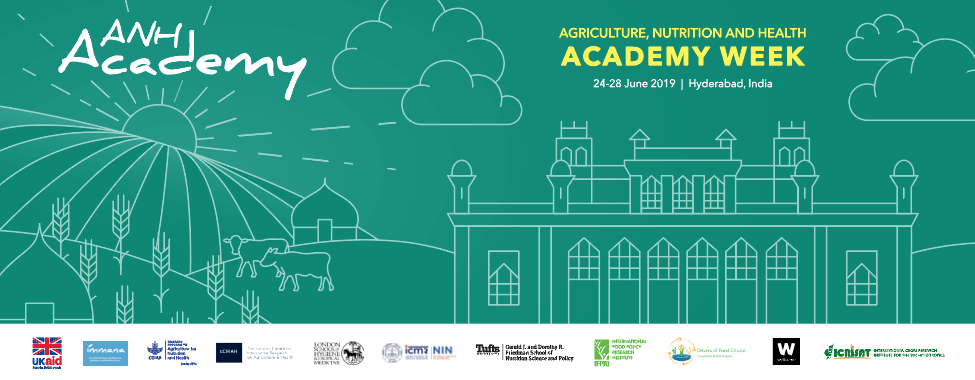
Three, 10-minute abstract-driven presentations.
Speakers and Presentations:
- Chair: Robyn Alders, University of Sydney and Chatham House
-
Nilupa Gunaratna, Purdue University, USA
Evaluation of chicken intensification and nutrition-sensitive social and behavior change interventions in Ethiopia: A cluster-randomized controlled trial
Slides/ Recording -
Hassan Ishaq Ibrahim, Federal University Dustin-Ma, Nigeria
Farmers’ awareness, knowledge and perception of zoonotic diseases: Evidence from northern Nigeria
Slides/ Recording -
Haile Tesfay, International Potato Center
A nutrition-sensitive agriculture project improved household and child dietary diversity and increased consumption of animal source foods: Evidence from Ethiopia
Slides/ Recording -
Q&A
Recording
Abstracts:
Evaluation of chicken intensification and nutrition-sensitive social and behavior change interventions in Ethiopia: A cluster-randomized controlled trial
Nilupa Gunaratna, Purdue University, USA
Introduction: Despite strong recent interest in household chicken production as a mechanism to improve dietary diversity and nutritional outcomes in vulnerable populations, the evidence for such benefits remains limited. Among chicken-producing smallholders in rural Ethiopia, we evaluated the effects of an on-farm trial that increased chicken flock size and promoted improved production practices, delivered either alone or in conjunction with a nutrition-sensitive social and behavior change (SBC) intervention package, on women’s dietary diversity.
Methods: Two interventions were evaluated in a cluster-randomized trial (n=60 villages and 2117 households): (1) an on-farm evaluation, implemented by the African Chicken Genetic Gains (ACGG) Project, which provided 25 young chickens of improved genotype, with training and support to improve production practices, to households that already had flocks of <50 chickens (average prior to distribution: 6.9 chickens), and (2) a nutrition-sensitive package of interventions implemented by the Agriculture to Nutrition (ATONU) Project, which addressed family nutrition with an emphasis on dietary diversity; improved water, sanitation, and hygiene (WASH) practices, especially related to chicken production; empowerment of women in household decision-making and budgeting; and vegetable gardening. The nutrition-sensitive interventions were delivered through group and individual meetings with both household heads and women of reproductive age over a 14-month period. Villages were randomized to receive no intervention, the chicken intervention only, or the chicken intervention combined with the nutrition-sensitive intervention package. Data were collected on maternal and child diets and nutritional status as well as individual and household practices at three time points: before, during, and after implementation of the nutrition-sensitive interventions. (ClinicalTrials.gov Identifier: NCT03152227)
Findings: Although women’s dietary diversity increased over time, it remained low, with ≤15% of women consuming at least five out of 10 food groups per day at any time. The increase in dietary diversity was 0.2 food groups/week greater in the joint intervention arm compared with the control (p=0.049) and chicken-only arms (p=0.071). The intervention arms, which both received improved chickens, had a significantly higher proportion of women consuming eggs in a seven-day period than the control arm (both p<0.001), while chicken meat consumption remained infrequent (<10% of women/week across arms). Both women of reproductive age and household heads (mostly male) receiving the nutrition-sensitive interventions could list marginally more food groups as part of a diverse diet. Similarly, women receiving the nutrition-sensitive interventions reported a small increase in their input into household decision-making on agricultural activities (p=0.040 compared with the chicken-only arm). Despite the interventions, poor WASH practices related to chicken production remained prevalent: over half of households reported chickens sleeping in the home at night and animal feces were observed in the majority of household compounds, with no significant differences among study arms. Household food expenditures were highly variable, also with no differences among study arms.
Conclusions: Coupling of nutrition-sensitive SBC messaging with an agricultural intervention to increase chicken production may realize additional improvements in women’s dietary diversity and empowerment in chicken-producing households. However, the effects are small and a longer duration of intervention may be required. Further, for impact on diets that could translate into improved nutritional status while meeting a household’s desire for income, greater chicken production may be needed, moving households towards a semi-commercial model. WASH remains a challenge in rural Ethiopia and may need additional intervention to mitigate exposures, particularly as chicken production is increased.
Farmers’ awareness, knowledge and perception of zoonotic diseases: Evidence from northern Nigeria
Hassan Ishaq Ibrahim, Federal University Dustin-Ma, Nigeria
Introduction: Rearing of livestock is a common practice among rural farming households in Nigeria. Zoonoses are diseases that are transmissible between animals and man (WHO, 2006). Zoonoses pose a serious threat to human and animal populations, food security, and the economy of Nigeria (Ngutor, 2012). The large number of pastoralists, especially in northern Nigeria, is a clear indication of the occurrence and spread of zoonotic diseases in Nigeria. The current study is thus aimed at improving our understanding of farmers’ level of awareness, knowledge, and perception of zoonotic diseases, thus enabling policy decisions that will help to control the menace.
Methods: The study was conducted in 10 villages selected across Katsina State (12.51390N, 7.61140E), North West Nigeria. The villages were selected based on their popularity with livestock rearing and high population of Fulani cattle rearers. A village listing survey was conducted to obtain the population of farmers (sample frame) in each of the selected villages. Random sampling was used to select a total of 200 respondents for the study. The respondents were selected in a proportionate manner based on the population of farmers in each village. Primary data was used for the study and was collected during a household survey and a focus group discussion with a different set of 6-10 farmers per village. Data was collected by trained enumerators from the Department of Agricultural Economics, Federal University Dutsin-Ma, Nigeria in November 2018. Data was collected on farmers’ socio economic characteristics, level of awareness of zoonoses, knowledge of transmission, prevention and treatment of zoonoses, drivers of zoonotic diseases infection and perception on zoonoses. Data were analyzed using descriptive statistics and perception index.
Findings: Our results revealed that an average farmer in the study area is male, married, and with an average age and household size of 46 years and 6 persons respectively. Livestock are kept under the semi-intensive method of management. Livestock diseases occur frequently but visits to veterinary clinics are not regular. The major zoonotic diseases known by the respondents are rabies, Lassa fever and ebola virus disease (EVD). The perception index score of respondents indicates that zoonotic diseases are an important public health concern. The level of knowledge of routes of transmission, symptoms of zoonotic diseases, and knowledge of prevention and treatment of human infections are unsatisfactory. Focus group discussions revealed that the public awareness created by government health agencies during the EVD incidence in Nigeria in 2014 contributed to the level of awareness of some selected zoonotic diseases especially EVD. We also found that the semi-intensive method of management, low level of awareness of most zoonotic diseases, delayed treatment of infected persons, consumption of raw and under processed livestock products, and the close proximity of animal housing and farmers’ residential areas are the key drivers of zoonotic disease infection in the study area.
Conclusions: Based on findings, we conclude that the level of awareness of other deadly zoonotic diseases such as brucellosis, anthrax, Lassa fever, tuberculosis, and the highly-pathogenic avian influenza is very low among farmers in northern Nigeria. Government health agencies and mass media outlets can help to increase the level of awareness as was the case during the EVD outbreak of 2014. Encouraging farmers who own livestock to patronize veterinary services, educating them on symptoms, preventive measures, and treatment of infected persons will help to reduce the incidence of zoonotic diseases in the study area and the country at large.
A nutrition-sensitive agriculture project improved household and child dietary diversity and increased consumption of animal source foods: Evidence from Ethiopia
Haile Tesfay, International Potato Center, Peru
Introduction: Advances in agricultural production, processing, and marketing systems have positively transformed many national economies and increased overall agricultural productivity, but not eliminated food insecurity or malnutrition. One lesson from the paradox of growing rates of malnutrition and food insecurity alongside higher than ever crop yields is that agricultural productivity alone – the focus of many nations’ agricultural policies – does not guarantee improved food security or positive nutrition outcomes. This study adds to the literature by characterizing mechanisms of a scaled-up, nutrition-sensitive agriculture intervention that combined delivery of household agronomic activities with community nutrition and health services.
Methods: Recognizing multi-sectoral efforts may better address malnutrition’s underlying determinants, a nutrition-sensitive agriculture project was established in Ethiopia. The project goal was to improve nutrition of participant households by increasing production and consumption of orange-fleshed sweet potatoes (OFSP) as part of diversified diets. This study had two objectives. First, to analyze effects of a scaled-up, nutrition-sensitive agriculture project on agronomic production, maternal nutrition knowledge and behaviors, and child and household dietary intake patterns in rural Ethiopia. Second, to characterize how these changes occurred, with consideration to the project’s impact pathways and multiple ecological levels. Structured surveys were conducted among rural households in Tigray and the Southern Nations, Nationalities, and Peoples (SNNP) regions of Ethiopia. Participants included rural households (n=577) that had at least one child between the ages of 12-59 months from 20 woredas (districts). Households were randomized to either the control group (T0=188) or to receive integrated agronomy and nutrition activities (T1=389). To control for potential confounding factors, the difference-in-difference (DID) approach was used to estimate treatment effects of the intervention using data from control and intervention households at baseline and follow-up periods. Statistical analyses were conducted using SAS® version 9.2. P-values <0.05 were considered significant.
Findings: Baseline analyses revealed no significant differences between the T1 and T0 groups in most household attributes. On average, households had 6.5 family members, 7.0% were female-headed, and the age of the head of household was 38.0 years. The proportion of all households classified as food insecure increased between baseline and follow-up periods. At follow-up, however, a smaller proportion of T1 compared to T0 households were classified as food insecure, 57.8% versus 66.1%, respectively (p=0.06). In spite of this, participation in the program (T1) was associated with significantly greater household production of orange fleshed sweet potatoes (DID +81.2%, p<0.001), having a kitchen garden (DID +16.8%, p<0.001), maternal knowledge about nutrition and feeding practices (DID +34.6%, p<0.001), child consumption of animal source foods (DID +18.9%, p<0.001), child dietary diversity scores (DID +0.8, p=0.002), and household dietary diversity scores (DID +0.6, p=0.001). Households in the study area were practicing Orthodox Christians, who observe fasting during periods of the year (N.B., to Ethiopian Orthodox Christians, fasting means abstaining from dairy and animal products). Among all households, a lower proportion fasted at follow-up. However, there was a significantly lower proportion of T1 households reported fasting (DID -16.6%, p<0.001).
Conclusions: Rates of food insecurity increased for all households, in part due to severe climatic events that occurred in the region. In spite of this, participation in the program was associated with child and household dietary improvements. Delivering behavior change strategies that address social norms throughout multiple community settings and emphasizing care and feeding practices with mothers and fathers were critical factors for impact on child nutrition. Our findings informed an expanded theory of change framework to describe how, using OFSP as an entry point, the project improved dietary outcomes and community food environments through multi-sectoral pathways.




